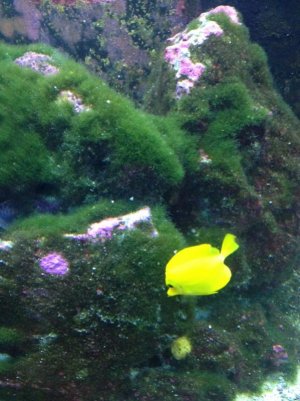Phosphate flow out of rocks
Many people, when they get their nutrients low for the first time, get worried when more (not less) algae starts to grow on their rocks. It seems really strange, especially when nitrate and phosphate have gone lower than before. What is happening is that phosphate is coming out of the rocks. Remember, phosphate is invisible, so you can only see the effects of it, and it always "flows" from higher concentrations to lower concentrations (just like heat does).
Example: If your room is warm, and you put a cold object on the floor, heat from the air in the room will "flow" into the object until the object and the air are the same temperature. Example 2: If you put a hot object on the floor, heat will "flow" out of the object and go into the air in the room, again, until the air and the object are the same temperature. Now suppose you open your windows (in the winter). The warm air in your room will go out the windows, and it will get colder in the room. The object on the floor is now warmer than the air, so heat will flow out of the object and into the air, and then out the window.
Think of phosphate as the heat, and your rocks as the object, and your windows as the scrubber. As the scrubber pulls phosphate out of the water, the phosphate level in the water drops. Now, since the phosphate level in the water is lower than the phosphate level in the rocks, phosphate flows from the rocks into the water, and then from the water into the scrubber. This continues until the phosphate levels in the rocks and water are level again. And remember, you can't see this invisible flow.
This flow causes an interesting thing to happen. As the phosphate comes out of the rocks, it then becomes available to feed algae as soon as the phosphate reaches the surface of the rocks where there is light. So, since the surface of the rocks is rough and has light, it starts growing MORE algae there (not less) as the phosphate comes out of the rocks. This is a pretty amazing thing to see for the first time, because if you did not know what was happening you would probably think that the algae was mysteriously being added to your tank. Here are the signs of phosphate coming out of the rocks:
1. The rocks are older, and have slowly developed algae problems in the past year.
2. Your filters have recently started to work well, or you made them stronger.
3. Nitrate and phosphate measurements in the water are low, usually the lowest they have been in a long time.
4. Green hair algae (not brown) on the rocks has increased in certain spots, usually on corners and protrusions at the top.
5. The glass has not needed cleaning as much.
Many people have never seen the effects of large amounts of phosphate coming out of the rocks quickly. But sure enough it does if you keep nutrients low enough in the water. How long does it continue? For 2 months to a year, depending on how much phosphate is in the rocks, how much feeding you do, and how strong your filters are. But one day you will see patches of white rock that were covered in green hair the day before; this is a sure sign that the algae are losing their phosphate supply from the rocks and can no longer hold on. Now it's just a matter of days before the rocks are clear.


